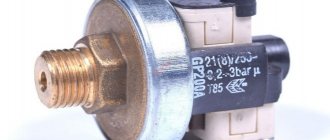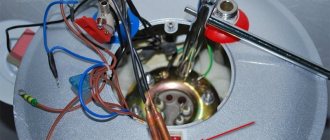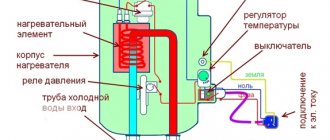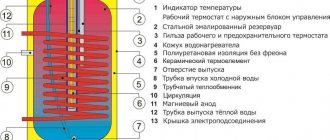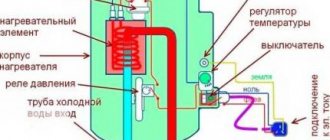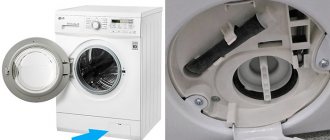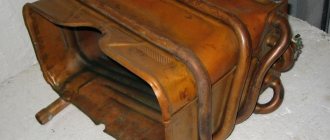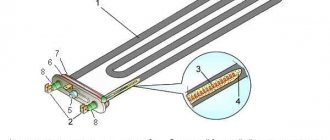Why do you need to clean your boiler?
If there is an odor in the water from the boiler, microorganisms are most likely to blame. The ideal environment for them is humidity and warmth. And this is enough in a storage water heater. They also often accumulate near the heating element, where sediment from poor-quality water remains.
Scale forms mainly on the heating element and the surrounding area. It is dangerous to human health. If you are going to drink water from the boiler. But even if the water is used only for domestic needs, there is no point in deluding yourself.
Lime deposits and metal have different expansion coefficients. Therefore, the heating element wears out due to constant on and off cycles. Scale also prevents the efficient transfer of heat to water, reducing the useful power of the water heater.
Reasons for the formation of deposits in a water heating tank
Scale is a hardened deposit that appears when a boiler is used for a long time. There are several reasons that contribute to the formation of plaque:
- Using too hard water. This liquid contains a lot of salt, which is gradually deposited on the walls of the boiler. Boilers in which hard water is heated are cleaned at least once every nine months.
- Strong heating of the liquid. If the water heater often heats the water to 65-70 degrees, traces of scale appear inside faster.
- Frequent use of the boiler. Water heating equipment that is used every day should be cleaned every 4-5 months.
Signs of scale in a water heater
- Noise appears during boiler operation. Typically, this electrical equipment operates almost silently, but scale can lead to unusual sounds and humming when heating water;
- The process of heating the water to the set temperature begins to take longer. Electricity is consumed, but the heating elements cannot heat the water properly due to the layer of solid deposits;
- The boiler begins to turn off more often to prevent overheating.
Stages of descaling the boiler:
- First of all, the electrical device is disconnected from the network. The safest thing to do is not just unplug the plug from the socket, but also turn off the machine and disconnect the wires from the thermostat.
- It is advisable to wait until the water in the tank cools down a little, it will be safer to work this way.
- The water supply valve to the boiler should be turned off to prevent the boiler from filling.
- The water from the tank must be drained, following the instructions for the boiler or the water supply diagram through the boiler.
- So, the boiler is empty, the water has been drained. Now you need to get to the heating element. To do this, first of all, the decorative cover of the tank is removed; it is usually secured with several screws. You will need a screwdriver. Let us clarify: for most standard vertical models of water heaters, you can remove the heating element directly on the wall, without removing the boiler itself from its mounts. However, for example, if you have a flat model mounted horizontally, it will be inconvenient to work with. In this case, after draining the water, it is advisable to remove the tank and move it to a place where you will be comfortable working with it;
- For some models, the thermostat is removed together with the heating element, for others it is pulled out of the housing;
- There are models in which the entire stand with heating element is held on by just one nut, so it will not be difficult to remove. Other models have more nuts - five or six, but in any case they must be unscrewed to get to the heating element.
- For ease of operation, the heating element removed from the water heating tank should be unscrewed from the lid on which it is installed. First of all, we wash the heating element under cold water to wash off the top layer of scale, possibly rust;
- The remaining plaque will have to be removed differently. The simplest chemical method is to soak the heating element in water with dissolved citric acid. Remember that citric acid is recommended as a folk remedy for preventing the appearance of scale in a washing machine. She copes well with the raid. To clean the heating element, citric acid should be diluted with water in a proportion of 10 grams (one sachet) per liter of water. The heating element is simply soaked in this solution for a while; check its condition periodically. To increase the effect, the citric acid solution should be heated;
- It is not recommended to clean hard, petrified deposits from the heating element with a knife - there is a risk of damaging the top layer if you are too zealous. If you decide to use a mechanical method, you can use sandpaper, but you should also act carefully;
- Instead of citric acid or vinegar, as folk remedies, heating elements can be cleaned with special anti-scale chemicals;
- The tank itself should also be washed. If you removed it from the wall, you will have to fill it in and then pour it out manually. If it still hangs in its place and it’s convenient for you to work, then simply turn on the water supply, but do not close the hole from where you pulled out the heating elements so that the dirt pours out immediately. You should walk along the walls of the tank with a rag to remove deposits. The inside walls of the boiler are enameled, there is no scale on them, but dirt may remain;
- Abrasive substances should not be used when cleaning the tank so as not to damage the walls;
- After cleaning the heating element and the tank, you should assemble the boiler - everything happens in the reverse order. The main thing is to securely tighten the connecting screws and nuts, install the thermostat, use a pipe wrap, connect the wires;
- Then we turn on the water, fill the boiler and connect it to the network to check how it will work now.
Methods for descaling heating elements
The choice of method and means of cleaning the heating element depends on the type of device.
Descaling the heating element of a washing machine
For automatic washing machines, water softeners are used, installed on the supply hose; they significantly slow down the formation of scale. Not everyone can disassemble the housing on their own to get to the heating element, especially since deposits can form on the walls of the tank and drum. Therefore, it is better to use the chemical method using citric acid:
- Wipe the inside of the tank and the rubber cuff with a damp cloth soaked in detergent.
- Pour citric acid into the washing powder tray. For a machine with a load of 5 kg, 100 g of the drug is enough.
- Select a washing program with a water temperature of +90 ºС, turn on the wash (without laundry), and after 5 minutes pause. After an hour, continue the cycle until it is completed.
- Wipe the drum walls and rubber cuff with a well-absorbing cloth, leave the hatch door open until completely dry.
In the same way, you can use any branded descaling product. When choosing a mode and dosage, you should strictly adhere to the instructions so as not to damage the rubber sealing elements of the mechanism.
Citric acid will help no worse than store-bought products
Popular preparations for cleaning heating elements of washing machines:
- anti-scale agent “Cinderella”;
- Top House;
How to descale heating elements in a washing machine
Descaling the heating element of the dishwasher
During the washing cycle, special salt enters the water from the dispenser, which reduces the formation of scale on the heating element. But particles of solid sediment often clog the holes in the water distributor. To clean the heating element from scale, you can use citric acid (200 g per 1 cycle), vinegar solution (9% table strength, 2 cups) or a factory product (use strictly according to the instructions).
The main thing is not to leave the product in the car for more than 40 minutes, so as not to damage the rubber sealing parts.
You need to act in the following sequence:
- Wipe the walls with a cloth.
- Add citric acid or vinegar to the chamber and run the wash with an empty basket, selecting the standard wash cycle.
- Stop washing after 15 minutes, without allowing intermediate drainage of water, wait half an hour and resume operation of the machine.
- Turn on the shortest mode to completely flush out the acid from all machine systems.
- Wipe the rubber seal dry with a cloth.
In addition to vinegar and citric acid, you can try a mixture of baking soda and hydrogen peroxide: this product is not so aggressive towards rubber seals.
Procedure:
- Mix soda (400 g) with hydrogen peroxide (3 tablespoons).
- Place the resulting paste on the bottom of the washing chamber.
- Run the longest wash cycle.
- Rinse the filter and repeat washing without adding detergents.
Special products for descaling PMM:
- Frau Schmidt tablets;
- Top House - express cleaner;
- Clean Home – express effect (descaler).
There are no miracles in the world: all advertised products that can be used to remove scale from heating elements contain citric or acetic acid. If you put aside your fears, you can use cheap home remedies, but it is important not to overdo it with the dosage and time of action.
Cleaning boiler heating elements from scale
In the boiler, except for the magnesium anode, there are no means of protection against scale and corrosion. In order to clean the heating element of the boiler from lime deposits, it is better to remove it.
You need to follow the sequence of actions:
- Shut off the water supply to the apartment by closing the inlet valve.
- Disconnect the boiler from the electrical network.
- Disconnect all wires by first taking a photograph of the assembled unit or sketching out a wiring diagram.
- Open the cold and hot water valves on the mixer.
- Drain the water from the boiler through the drain valve with the attached hose (into the bathtub, toilet or into a standing bucket).
- Unscrew the fastening screws and remove the decorative cover from the boiler, carefully remove the heating element (the fastening may differ for different models, the instructions from the manufacturer will help).
- Inspect the magnesium anode: if no more than 10 cm is left of it, it makes sense to replace it with a new one during the cleaning process.
- Remove scale and dirt from the interior of the boiler. It is advisable to collect everything in a plastic bag and throw it in the trash: hard pieces of sediment can clog drain pipes and sewers.
Severe case
Algorithm for descaling boiler heating elements:
- While the scale on the heating element is wet and soft, it is carefully scraped off using a wooden spatula or the back of a knife.
- Residues of plaque that have not left the metal can be easily removed using chemical action:
- in a tall vessel (saucepan or plastic bottle with the top cut off) dissolve 200 g of citric acid in two liters of warm water;
- immerse the heating element in the solution (only the part that is usually in water, where there are no connection terminals);
- leave in the solution overnight;
- Rinse thoroughly under running water to remove any remaining plaque and solution.
- To speed up the process, the solution with the heating element immersed in it can be heated on the stove (in a metal container).
- Return the clean part to its place.
- Insert a new anode into the heater block and install the thermostat.
Reassemble the boiler in the reverse order. Before turning on, you must check all connections for leaks. Particular attention should be paid to the electrical part. After checking, you can turn on the water and fill the tank, connect the boiler to the electrical network.
Cleaning the boiler and heating element from scale and dirt, draining water from the boiler
How to clean a boiler algorithm of actions
- Disconnect the boiler from the power supply.
- Drain the water.
- Clean the boiler.
- Carry out assembly and connection.
Disconnecting from the network and draining the water
To disconnect the water heater from the local power supply, you need to turn off the machine and disconnect the wires from the thermostat. After this, you can proceed to draining the water.
To do this, take a hose or thin tube, install it at the water collection outlet, on the safety valve, and open any hot water tap. This will allow air to enter the check valve. The drain pipe must be connected to the toilet or bathtub.
We recommend: What diameter of polypropylene pipes for heating is best
If the boiler does not have a safety valve or it is broken, then it must be installed later. Then the first step is to shut off the flow of cold water into the boiler and disconnect the supply hose. After this, connect the tube to the ball valve. Then we perform the steps described above.
How to drain water from a boiler
It is very convenient when the water heater is installed above the bathtub or in another place where you can freely place a large container under it. Then you can not waste time on this procedure, but drain the water immediately before cleaning the boiler, while removing the heating element. But it is worth warning that the design of some models of storage units may create difficulties for you during such emptying.
Advice. It is convenient to drain the water while removing the heating element in those water heaters where it is screwed directly into the tank. In other models, you have to unscrew several nuts holding the flange with the heating element, then it is better to empty the container in advance.
If the boiler is connected to the water supply correctly, as shown in the diagram, then there will be no problems with emptying for subsequent cleaning. The algorithm is like this:
- disconnect the device from the electrical network and close the general water supply tap;
- turn off the cold water tap near the heater, and open the hot water valve on the nearest mixer and wait until it drains;
- attach a tube directed to the sewer to the drain fitting, open the tap and drain the water.
When there are no taps or drain pipes, you can try to empty the tank through the safety valve. But in this case, cleaning the water heater will take a whole day. So it’s better to wait until the water in it cools down, and then act according to the algorithm outlined.
But since there is no fitting, you need to disconnect the hot water pipe from the boiler and place a bucket. To allow water to flow, carefully unscrew the safety valve. As soon as air begins to flow into the container, water will flow out of the nozzle. The valve can be removed completely and the intensity of the jet can be adjusted by plugging the “cold” pipe with your finger.
This way you will empty the tank relatively quickly. During reassembly, do not forget to assemble the circuit properly so as not to waste time next time.
Descaling
How to properly clean a boiler from scale is a rhetorical question. The fact is that you can do the cleaning yourself, and therefore the quality of the cleaning will depend on the quality of the work performed.
There is only one nut inside the water heater that needs to be unscrewed. She holds the heating element with a metal plate that needs to be removed.
After draining the water, the boiler must be removed from its mounts and placed on the floor, after which the thermostat must be pulled out. The ARISTON TI TRONIC 100 V model clearly shows how it is possible to clean the boiler. In order to get the heating element, you need to push the flange inward and then pull it out.
After removing the heating element of the boiler, simply use your hand or a rag to remove all accumulated scale from the tank. The tank is enameled from the inside, so there is practically no scale on the walls. Next, the tank can be rinsed under high pressure water or the walls can be wiped well with a rag.
After this, you need to properly assemble the boiler. To do this, we perform the same algorithm as during disassembly in reverse order and connect water and electricity.
Some problems with heating element
If the heating element is in poor condition, for example, there is heavy scale on the heating element, it will have to be replaced. Cleaning in such a situation is so problematic that it is easier to buy a new heating element. You need to buy a similar heating element with the same power.
When purchasing, look at the length of the contacts connecting to the thermostat (it should be identical to the old heating element). If the distance between the terminals is different, there may be no contact with the thermostat.
If the heating element is still normal and you managed to clean it, you can take a risk and try its further operation. Only you can decide how to clean your boiler. But it is undesirable to take risks, because safety depends on it: in case of aging, electric heaters tend not only to receive electric shock, but also to explode.
Magnesium anode in the boiler
– another important detail in the question of how to properly clean a boiler. It is located near the heating element and is destroyed during operation, so it is advisable to carry out regular replacement. To replace the anode, simply unscrew it. Next, install a new one in this place, which you can purchase in the store when purchasing a new heating element.
This procedure, as well as cleaning the boiler, should be carried out every two years. The service life of the anode depends on the frequency of use of the water heater.
Baths, saunas and swimming pools
81 votes
+
Vote for!
—
Vote against!
In those regions where there is no centralized heating, many use a domestic water heater, which is more often called a “boiler”. This convenient device helps solve many household hygiene problems. Today a boiler can be bought at any specialized store, but few people realize that even such a simple design requires maintenance. Not everyone who uses a water heater has had the opportunity to descale the boiler with their own hands.
Table of contents:
- Is it necessary to clean the boiler?
- Where does scale come from in clean water?
- Step-by-step instruction
Is it necessary to clean the boiler?
Many consumers have been using their household water heater for years without the obligation to descale it. Everyone understands that any heating element or heating element (tubular electric heater) becomes covered with calcium deposits or scale over time. Because of this, after 2-3 years the water heating time decreases and electricity consumption increases. This occurs due to physical phenomena - the thermal conductivity of calcium deposits on the heating element is several times lower than the thermal conductivity of the steel rod responsible for the operation of the device.
A small layer of scale has virtually no effect on the operation of the heating element, although a small thermal resistance is still present initially. Over time, the crust increases, and the heating element must first warm it up, and then the water. But this causes excessive stress on the water heater and takes a lot of time to warm up the entire volume of water. Over time, overheating of the pipes and gradual destruction of the heating device are observed.
Preventative cleaning of the boiler can be omitted for the first 2 years, but then disassembled after about a year and a half, removing scale from the heating element. This is done by specialists, but if you master all the basics and follow the instructions exactly, then it is obvious that there is nothing difficult in cleaning the heater of the boiler.
Experts recommend:
- set the temperature relay until hot water is received, but not before boiling, so that there is less scale;
- pay attention to the appearance of a characteristic hissing sound in the boiler, which indicates that it is time to clean it;
- clean if the water heater begins to turn on and off frequently or heats up for a long time;
- clean if the water from a warm tap has a yellowish tint and a strange unpleasant odor or pieces of scale come out in the form of sand;
- do not wait until the boiler becomes unusable, but do preventive cleaning.
Where does scale come from in clean water?
One of the simplest and most amazing substances on earth is water. It gives life to all living things, along with oxygen, while in its circulation between the bowels of the earth and the cloudy spheres it penetrates into calcareous rocks. Along the way, water dissolves all kinds of substances and solid minerals, carrying with it metal ions, magnesium and calcium.
In different areas, water differs in terms of acid-base reaction, that is, the content of microscopic limestone suspension. Therefore, water can be “soft” (alkaline) and “hard” (acidic). When heating hard water with a relatively high content of impurities, this calcium and other impurities settle on the surface of the heating element. A dense crust of this sediment forms, so the boiler needs to be cleaned periodically.
Scale in the boiler is deposited on the bottom, walls and heating element of the container, and a sediment consisting of contaminants also falls on the bottom. It is the hardness of the water that most influences the intensity of scale formation. Neva water, for example, has a low percentage of calcium salts, and in some regions the heating element of a boiler, kettle or electric samovar quickly forms scale.
When examining the sediment from a cleaned tank, you can find rust and a pasty sediment from a fine suspension of the boiler, dry heating element; cleaning will show:
- fragments of clay and chalk;
- remains of “brewed” microorganisms;
- Vodokanal bleach and other substances for water purification.
Advice: All this must be periodically removed from the boiler, and at the same time clean the Ariston boiler or (another brand) from the accumulated scale.
In addition, any metal container is subject to corrosion processes when interacting with water and oxygen dissolved in it. This chemical process affects all metal components - heating element, tank, pipe. The strength of the components of the water heater gradually decreases and can cause it to fail.
Advice: periodically it is necessary to replace the anti-corrosion magnesium anode with which the heating element is equipped.
It is not difficult to remove scale and sediment; the main problem is to properly disassemble the water heater and get to the main heating element when cleaning the boiler at home. Sometimes, after the first service, it is wise to install a filter and a so-called “electromagnetic scale converter” that counteracts this process.
The last stage of contamination of the heating element is when scale looks more like limestone, covering it completely. At the same time, heat transfer is not only difficult, but also practically impossible, and due to overloads during heating, the main part of the water heater simply burns out.
If the container and pipes are not damaged, then after cleaning and descaling you will only have to replace the magnesium anode, and not the entire heating element. The heating element is the most valuable and expensive part of the boiler, but it is better than buying and installing an entire electric water heater.
To avoid such complications, it is recommended to periodically descale the boiler. There are 2 ways:
- mechanical (depressurization and manual assembly);
- chemical.
Tip: Don’t forget about water softening and filters that are installed directly on the water pipes in your house or apartment.
Attention: Do not use hard metal brushes, files or other metal tools that professionals use to clean the heating element!
There is a good way to protect the boiler from scale - a magnetic filter. The principle of its operation is based on the action of powerful magnets that emit lines of force that magnetize water directly in the pipe. This affects the formation of crystals of calcium salts, which do not fully form a crystalline structure and cannot fully settle when heated. Instead of a cubic shape, they form a linear structure, which is poorly suited to sticking to surfaces.
Step-by-step instruction
Please note that heating elements in the catalogs are offered in different types:
- threaded;
- flanged;
- dry.
When choosing the required heating element, it is advisable to have the operating instructions for your water heater with you, and accordingly, the consultant will help you select the necessary components.
An important component that significantly extends the life of the electric heater is the magnesium anode. This metal element is coated with a layer of magnesium alloy to initiate physical and chemical processes to protect the tank and heating element from corrosion. This metal element has a service life because over time it loses its effectiveness.
The anode is replaced annually when cleaning the water heater. If the water hardness is low, it does not require replacement as often. To do this, you need to perform a number of steps when cleaning a Gorenje or other type of boiler. Although today there is a sufficient range of heating elements and anodes for them on sale, it is still better to choose a “native” one for each brand and type of boiler.
For each brand or model of water heater there is a special type of magnesium anode; it is advisable to replace the anode with a “native” one.
1. Although this work is not difficult, the tank itself is heavy, so it is better to dismantle it with an assistant. Turn off the taps and water supply valve on the water heater. Disconnect the boiler from the mains by removing the plug from the socket.
2. Disconnect the cold water hose from the water supply and lower it into the bathtub; however, it is not necessary to disconnect the warm water hose from it. Place the removed hose on the boiler safety valve and lower the freed part into the shower pan or bathtub.
3. Now you can open the water heater taps and unblock the water heater back-safety valve, open the hot water taps in the bathroom and kitchen. The boiler will first draw in air noisily, then a portion of water will be discharged through the operation of the valve.
4. After draining all the water, blow out the cold water hose - if there are no gurgling sounds, then you can continue working.
5. It's time to unscrew the hose that supplies hot water to the faucet. The boiler can be dismantled and placed on the floor with the taps facing up.
6. Use screwdrivers to unscrew the bolts and remove the front cover of the water heater. It’s better to use a screwdriver to lightly pry the panel near the thermostat knob, then carefully pry it from the back side with another and pull it a little. The panel latches should engage, coming out of the door fasteners, and now it can be dismantled, as well as the thermostat holder.
7. Next, you can unscrew the remaining screws that secure the protective door and carefully remove it. An electrical wiring diagram will open, which is worth drawing if you don’t have a ready-made printed one. It is very convenient to take a couple of pictures on your mobile phone from different angles, so that when assembling you can understand how everything should look when assembled.
8. Now it’s time to carefully disconnect the power cord. Don't forget to remove the ground wire. After this, remove the rubber gasket-seal and the heating element with the french.
9. The main part is preparing the tank and metal parts of the main heating element for cleaning the boiler from scale manually.
10. After removing scale and sediment, rinse the inside of the tank with a hose.
Attention: Be careful with the magnesium anode, which is very sensitive to damage from the chemically active surface! You cannot pick out the scale with a sharp metal tool or anything that can scratch it.
11. After cleaning is complete, you can replace the old anode with a new one if replacement is required. This is done in accordance with the instructions attached to it, since the design of each brand has its own distinctive features.
12. When everything is ready, reassemble the boiler in exactly the same way as you disassembled it, but in reverse. After this you can plug it into the network. If water flows into the “warm” faucet tap, then everything works and the tank is already full.
13. After checking the attachment points of the element, where there should be no leakage, the water heating device can be connected to the power supply. It is advisable to dry them with a hairdryer before connecting the plug to the socket.
Attention: It is not always necessary to remove the tank, especially if it is located in a place convenient for maintenance. If it is not possible to route the hose into the bathtub, it is enough to place a large basin of water or other container underneath it. But keep in mind that there is a lot of water, depending on the volume of the tank.
Experts recommend removing scale from the heater and the walls of the container with a specialized boiler cleaning agent, such as anti-scale. It is diluted according to the instructions to rinse the boiler with it, which then needs to be rinsed.
If you do not find a magnesium anode in the design of the old boiler, then it is advisable to change the entire heating element. When purchasing, it is important to know the thread sizes.
So you are convinced that cleaning the boiler with your own hands is not as difficult an undertaking as it seems. After you have mastered it yourself, your friends, relatives, and neighbors will have the opportunity to do it.
Cleaning a water heater takes 2-3 hours on average. To avoid any doubts, watch the boiler cleaning video:
Flushing the boiler without removing it
There are several ways to descale your boiler. It is impossible to say which one is more effective - it all depends on the quality of the water and the substances it contains. You may have to try them all. These methods will also help to flush an indirect heating boiler.
Method No. 1 - citric acid
You will need a large amount of citric acid, at the rate of one 20-gram sachet per liter of boiler volume. For example, a 50-liter water heater will require 0.8 kg of citric acid.
Actually, the procedure:
- Dilute citric acid in a ratio of 1 to 3 with water;
- Pour the resulting mixture into the boiler through the water supply hose;
- Connect the hose to the water pipe;
- Turn on the boiler and wait until it is completely filled;
- Set the maximum temperature and wait until the water heats up;
- Drain the water.
Method number 2 - vinegar
To clean, you will need vinegar or 70% vinegar essence. If you use regular 9% vinegar, you will need 100 ml for each liter of boiler volume.
If you use 70% essence, then you need 13 ml for each liter of boiler volume. For a 50-liter bottle you need to take 650 ml of essence. But before use, dilute it in 2-25 liters of plain water.
How to descale a boiler with vinegar:
- Pour vinegar or essence solution through the water supply hose;
- Connect the hose to the water supply and completely fill the boiler;
- Turn it on to maximum temperature;
- Wait until it warms up completely and leave it like that for 30-35 minutes;
- Drain the water.
Method number 3 - baking soda
To descale your water heater, you will need baking soda (NaHCO3) in the amount of 25 grams per 1 liter of tank volume. It must be completely diluted in water in a ratio of 1 to 12 at a temperature not exceeding 55 degrees. If the baking soda gets hotter, it will decompose.
We recommend: Ariston gas boiler error codes indicate malfunctions
Usage:
- Pour the soda solution into the boiler through the water supply hose;
- Turn on the water heater, wait until it fills;
- Set the temperature on the regulator to 55 degrees and wait for the water to heat up;
- After the water has warmed up, leave the boiler on for an hour;
- Drain the water.
By professional means
This method is less effective than the mechanical one, but it is easier to use and does not involve the risk of element breakage. Before starting descaling work, it is recommended to remove the water heater from the wall and clean the inside of the tank. The container is filled with a special solution containing a chemical.
For water passing through rusty water pipes, products containing phosphoric acid are recommended. Experts recommend getting rid of scale that destroys the water heater using:
- Cillit ZN/I;
- Aipakon;
- AlphaPhos;
- Thermagent Active.
For equipment that has served for more than 2-3 years, descaling agents based on other acids are not recommended.
You can clean the inside of the water heater using a surfactant-based product. Steeltex and Alumtex are considered the best in this segment.
Carefully read the instructions on how to clean your water heater from scale deposits! The manufacturer indicates the exposure time of the solution on the packaging!
In most cases, you should prepare a solution: mix the product with water in the required concentration. Open the cold water supply to the boiler, drain hot water by 2/3. Using the reverse connection of the water heater, it is necessary to pour the solution inside the tank. Leave for 5-6 hours, drain through a hot running tap.
Mechanical method
When you finally have a heating element in your hands, you can evaluate the quality of your tap water. Don't wait for it to dry. Carefully remove the wet layer of scale with a wire brush.
If you don’t have such a tool on your household, you can clean it with a wooden spatula or knife. After the operation to remove plaque, polish the heating element with sandpaper. Remember, the cleaner the surface, the less electricity the water heater will consume.
Why clean the tank and heating element of the boiler?
A boiler is essentially a large 50, 80, 100 liter or more container for heating water. As you know, scale usually forms on the surfaces of water heating appliances (such as a kettle). The quantity and speed of its appearance directly depends on the quality and hardness of the water used. The harder the water and the higher the temperature, the more plaque there is. Scale is a sediment that forms and settles in the form of plaque during the breakdown of calcium and magnesium salts during heating of water.
Try actively boiling ordinary untreated water from the water supply system in a kettle for a couple of months, and then look into it. Now imagine what’s inside your boiler, which has been working for several hours a day for more than one year.
If scale is not cleaned periodically, it grows like a snowball. Thus, it creates a powerful heat insulator on the heating element, which simply does not allow the heating element to heat the water . As a result, it heats itself, and as a result it burns out.
How to clean a boiler with disassembly
Owners of small-volume boilers are recommended to disassemble the unit in order to completely clean the parts from scale and return the device to its initial efficiency indicators.
It is important not to damage the machine controls during the process. To carry out work on the water heater, you will need the following tools:
- open-end wrenches of different sizes;
- screwdrivers of various shapes and diameters;
- Adjustable wrench;
- standard plumbing key.
To clean a water heater from a layer of scale, it must be disconnected from the electrical network and shut off the flow of cold water. Wait a couple of hours so that the water temperature drops and does not cause burns. Open the hot water tap and empty the tank.
Next, carry out work to remove scale according to the following scheme:
- Disconnect the hot water supply hose and open the appropriate tap on the mixers to drain the residue.
- Carefully disconnect the power cable with terminals from the heater and thermostat.
- Start unscrewing the flange to which the heating elements are attached, allowing the remaining water in the tank to gradually drain out. Remove completely.
Take a photo of the internal connections of the water heater to avoid confusion with its electrical diagram.
The removed heating element must be descaled. You need to remove the layer with a sharp tool. An object with an abrasive surface, a chisel or a knife, is suitable for this purpose. Remove carefully, being careful not to leave damage to the tube.
The storage tank should be cleaned of mucus and other contaminants using a plastic scraper or brush. It is not recommended to put pressure on the body or rub it hard, as this can damage the walls and break the seal.
After descaling work, it is necessary to reassemble the water heater in the reverse order of dismantling.
Examine the electrode for wear. Damage can be determined visually - reducing the length of the rod to 20 cm.
Before installing the water heater, it is recommended to clean and treat the rubber parts of the boiler with sealant. This will prevent water leakage during operation and reduce the risk of scale formation.
After installing the heating element, you must:
- Hang the water heater on the wall.
- Connect to the pipeline.
- Turn on the hot water tap, open the cold water supply.
- Fill the boiler with water and check for leaks.
- Reinstall the thermostat and connect the wires.
- Replace the safety valve.
- Connect the device to the network.
If you regularly clean the water heater from scale and rust, the process will go quickly and will help extend the life of the device.
Disassembling the water heater
The device should be disassembled by turning it upside down. Next we proceed in the following order:
- remove the front panel by releasing the latches that secure it and picking it up with a screwdriver;
- pull the handle of the temperature regulator and carefully remove it;
- loosen and remove the screws that secure the panel;
- disconnect the cable through which the device is powered (it is held on by three screws);
- We remove the temperature regulator and the flange that ensures water heating.
How to clean the heating element from scale?
The heating element is located on the flange, which we removed from the water heater last when we disassembled the device.
Having examined the heating element, we will most likely find a thick layer of scale and other dirt deposits on it. The most effective way would be to simply remove this plaque mechanically. To do this, arm yourself with a not very sharp knife or cutter and carefully scrape off the dirt, trying not to damage the metal surface of the heater. After this, we install the heating element in place and assemble the boiler in the reverse order.
Cleaning the tank
It is recommended to remove such contaminants from the inner surface of the tank only by chemical means, since otherwise there is a high probability of damaging the tank. You need to proceed as follows:
- manually remove all dirt from the tank, which easily comes off;
- Pour cleaning agent diluted in water into the tank;
- we wait the allotted time;
- pour water from the tank;
- remove any remaining dirt with a soft sponge;
- Rinse out any remaining dirt and cleaning agent from the tank.
When cleaning the tank, do not use sharp objects or sandpaper, or touch the magnesium rod.
Reassembling the boiler after cleaning
After cleaning and disassembly is completed, the water heater is reassembled. All actions are performed in reverse order:
- The thermostat with heating element is put in place and the flange is screwed on;
- the boiler is hung on the wall;
- cold water and hot water pipelines are connected to the nozzles;
- the storage tank is filled with water and tested under pressure to ensure there are no leaks;
- if the test is successful, connect the electrical cable, put the decorative cap in place, and then try to heat the water.
We recommend: Heating a house with electricity: the most economical way: tips
During reassembly of the water heater, it is important to carefully inspect the gaskets. They are well cleaned from dirt, but it is better to buy new ones
To prevent leakage, the gaskets are lubricated with sealant.
Rules for cleaning a water heating device
Before you start cleaning, you must choose a method for removing contaminants:
- chemical, involving partial or complete disassembly of equipment;
- mechanical, requiring removal of the heating element and other components from the tank (to provide access to surfaces).
With the chemical method
To clean the heating element using a chemical method, it is necessary to partially disassemble the device, which is disconnected from the water supply and electrical networks. For flushing, you will need a reservoir that allows you to completely immerse the heating element in the liquid. After filling the reagent (liquid temperature within +50...+60°C), it is necessary to immerse the unit in the solution. The rubber sealing rings should be removed or the parts should be protected from acidic cleaning agents. The cleaning process takes 30-40 minutes, then you need to remove and rinse the heating element with running water.
Plaque on the surface of the tank does not need to be removed, since lime deposits provide additional thermal insulation. Scale reduces the rate of corrosion of ferrous metal tanks, but most manufacturers use either stainless steel or a special enamel coating. During chemical cleaning, the magnesium anode should be inspected; if wear or damage is detected, a new element should be installed.
After completing the cleaning, it is necessary to reinstall all the removed parts and check the operation and tightness of the water heater.
During mechanical cleaning
Before cleaning the water heater from scale mechanically, it is necessary to prepare the tool and disconnect the equipment from the pressure line and hot water supply hoses to consumers. After draining the liquid, it is necessary to dismantle the device and begin disassembly. If a thick deposit of lime deposits is found on the removed heating element, which cannot be removed by mechanical action, then it is recommended to purchase a new unit. You can select the right model and order spare parts in the online store (Tyumen).
To remove contaminants use:
- plastic scrapers;
- hard kitchen sponges.
Do not use metal rods or abrasive tools (such as files or sandpaper). There is a magnesium anode rod inside the tank, which reduces the rate of scale formation. During mechanical cleaning, force on the element is prohibited.
Boiler care rules
To ensure long-term and efficient operation of a storage water heater, you need to know and follow several simple rules:
Since the resulting scale and organic deposits are a consequence of the increased hardness of the consumed water, installing additional filters directly in front of the inlet pipe significantly increases the life of the boiler.
Proper and timely cleaning of the device will reduce heating time, extend the service life of the heating element and reduce energy consumption.
During operation, it is necessary to constantly monitor the condition of electrical wiring and grounding.
Do not use a faulty unit.
If any malfunctions are detected, immediately contact your nearest service center.
Important!
It is strictly forbidden to connect an unfilled water heater to the electrical network.
In most cases, failure of storage water heaters is associated with violation of maintenance intervals or non-compliance with operating rules. Timely cleaning of water heater elements from scale not only ensures effective heat exchange, but also increases the service life of the heating element.
Do-it-yourself cleaning of water heaters from odor inside
Many owners of water heaters notice over time that the heated water begins to smell terribly. This unbearable smell may have several reasons:
- Dirty water is supplied to the boiler. If there are a lot of foreign impurities in the water, especially hydrogen sulfide, it emits an unpleasant odor.
- There are specific bacteria and fungi in the tank. Such living creatures are born in the limescale deposits on the walls of the container. As long as there are not many microorganisms, the smell of the water does not change. But over time, their number increases, and the water begins to stink.
- Cheap or damaged water supply. Low-quality tubular plastic transfers its chemical smell to water. And old metal water pipes are ideal for the life of bacteria and fungi.
Water with hydrogen sulfide is impossible to smell
There is a way to determine which of these cases occurs:
- Run cold tap water for 5 minutes. Then place a clean bottle under the stream and close it after filling. After half an hour, you need to open the bottle and check the smell of the water. If it smells bad, there is a problem with the pipes or water.
- If cold water from a bottle smells normal, you need to look for the reason in the boiler itself. To do this, you again need to fill the plastic container, but only from the hot tap closest to the water heater. We wait 30 minutes and smell. If you can’t breathe from the bottle, it means there are harmful microorganisms in the tank.
In order to eliminate the unpleasant odor due to bad water or rusty pipes, you can do the following:
- Install a filter that removes bad-smelling gases from the water.
- Complain to the SES about the poor quality of tap water.
In the first case, you don’t have to wait for someone to come and fix the problem. Therefore, if you can’t stand the smelly water, it’s easier and faster to install a filter.
Problems with microorganisms in the boiler are solved differently:
- Sterilization of the tank. The water in the boiler is brought to a boil and remains in this state for a long time.
- Removing scale from a water heater (see above). This will destroy the favorable environment for the proliferation of microbes and bacteria.
To prevent smelly water from coming out of the boiler again, you need to follow simple preventive measures:
- Do not leave water in the water heater when it is not in use for a long time.
- Periodically descale the tank.
- It is advisable to install a filter.
- Pay attention to water quality. If necessary, contact the sanitary and epidemiological station.
Recommendations for disassembly and descaling
In principle, the entire boiler cleaning procedure is considered simple, and therefore can be done with your own hands without difficulty. But first, the device must be disassembled and the heating element removed, for which it is necessary to remove the decorative cover covering its mount and contacts from the bottom. It is usually secured with screws, and in some models of water heaters they are covered with a plastic panel. The latter is held on by plastic clips; to remove it, you just need to pry it off with a flat screwdriver.
When the screws are unscrewed and the cover is removed, the fasteners and contacts will be revealed. In order not to remember the connection diagram, the easiest way is to photograph it from several angles. Then the wires are disconnected and access to the thermostat is opened. Often you can simply pull it out of the heating element body; in other models you have to remove them together. After unscrewing the fastening nuts or the tubular heater itself, carefully remove it from the tank.
Advice. It is necessary to remove the heating element from the boiler very carefully, since the accumulated scale in the water heater often does not allow this to be done easily. In devices that have not been cleaned for a long time, you even have to pick out the dirt during the process, otherwise the element will not be pulled out.
It should be noted that the bulk of the scale is concentrated near the heating element, and there is little of it in the tank itself. The easiest way is to place a bucket underneath, briefly open the cold water tap and thus wash off any remaining dirt from the boiler. If there is severe contamination, when the walls of the tank are covered with plaque, then you must try to remove the scale manually. At the same time, it is unacceptable to use abrasive means to remove it from the enamel surface. When this does not help, there is nowhere to go - you will have to dismantle the water heater and clean it with various chemicals, which will be discussed below.
Advice. Take this opportunity to examine the condition of the magnesium anode and replace it if necessary.
We carefully remove a thick layer of scale from the surface of the heating element mechanically, for example, with a knife. Then we cut off the neck of the plastic bottle and fill it with a warm solution of citric acid (proportion – 2 bags per 2 liters of water).
We immerse the element in a bottle with a solution and leave it for a day, after this time the heating element will be as good as new. After this, all that remains is to assemble the boiler with your own hands, fill it with water and continue to operate quietly.
When is the best time to contact a specialist?
The design of the boiler is not complicated, but not in all cases it is possible to cope with problems and clean it yourself. Calling a plumber is justified if there is a water leak or the device does not turn on.
A qualified specialist will carry out diagnostics using a special tester without disassembling the water heater. The malfunction of the heating element can only be determined using the device. If a part burns out due to scale, the technician will replace it. Repair of a failed tube is not carried out.
The cause of the malfunction may lie in the temperature sensor. If after the measurements it turns out to be faulty, you will have to purchase a new water heater.
The specialist will also inspect other systems and help identify faults. After repair, the boiler will be cleaned of deposits using mechanical or chemical methods. The choice depends on the customer and the volume of the tank.
Cleaning the boiler from scale means extending its service life and ensuring proper operation of all device control systems. Regular flushing of the water heater will prevent the formation of a dense layer of scale, which reduces efficiency. Experts recommend combining the chemical method with the mechanical method to achieve maximum results. Analysis is carried out once a year, treatment with chemicals every 3-6 months.
Useful tips for cleaning your water heater
Before you rush into battle, trying to remove all the scale that you find inside the device, we recommend that you listen to our advice.
- Do not start cleaning the boiler alone! Even the most compact storage water heater still weighs a fair amount. Therefore, it is better to ask a friend to help you - this will help avoid both possible injuries and damage to the device. Remember that storage models may fail if dropped.
- Turn the appliance on and off from the mains only if there is water in it! Please remember that turning on the unit empty may result in a fire.
- If you have successfully completed all the cleaning and replacement of components, then fill the device with water and wait 2-3 hours! It happens that the flange of the water heater may leak. If you did everything correctly, there are no leaks, then you can breathe out and use it without fear.
- Wear personal protective equipment if you use a chemical cleaning method. Believe me, acid fumes are unlikely to be beneficial to your health.
